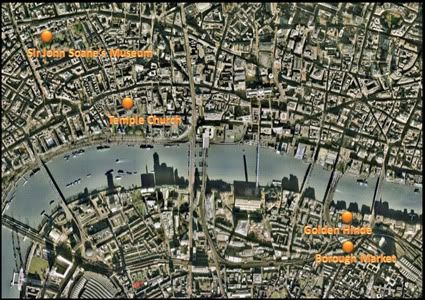
Borough Market
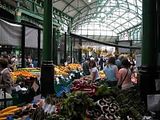 The Market itself claims to have existed since pre-Roman times and most probably did, but the earliest dependable sources mentioning it are from 1276. The market has focused historically on fruits and vegetables, but has recently become a fashionable centre for fine food, with some of the most famous traders opening stalls there. As expected, it has appeared in a number of films, such as "Harry Potter", "Bridget Jones", "Lock, Stock and Two Smoking Barrels", etc.
The Market itself claims to have existed since pre-Roman times and most probably did, but the earliest dependable sources mentioning it are from 1276. The market has focused historically on fruits and vegetables, but has recently become a fashionable centre for fine food, with some of the most famous traders opening stalls there. As expected, it has appeared in a number of films, such as "Harry Potter", "Bridget Jones", "Lock, Stock and Two Smoking Barrels", etc.Golden Hinde
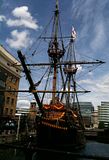 That's one of the coolest attractions in London. In 1577, Queen Elizabeth I gave Francis Drake a letter of marque which allowed him to act as a privateer attacking Spanish ships along the Pacific coast of the Americas. After an initial setback, he set sail on Dec. 13 aboard Pelican with four other ships and 164 men. Off the coast of Africa, he captured a Portuguese merchant ship, whose captain had considerable experience navigating in South American waters.
That's one of the coolest attractions in London. In 1577, Queen Elizabeth I gave Francis Drake a letter of marque which allowed him to act as a privateer attacking Spanish ships along the Pacific coast of the Americas. After an initial setback, he set sail on Dec. 13 aboard Pelican with four other ships and 164 men. Off the coast of Africa, he captured a Portuguese merchant ship, whose captain had considerable experience navigating in South American waters.At some point during its voyage, an officer attempted a mutiny, for which he was executed. As seamen are extremely superstitious, they decided to rename the ship,
 so that the ghost of the officer would not be able to haunt it. They chose "Golden Hinde".
so that the ghost of the officer would not be able to haunt it. They chose "Golden Hinde".Drake's voyage helped to give a more accurate picture of the true geography of the world. He discovered that Tierra del Fuego, the land seen to the south of the Magellan Strait, was not part of a southern continent as had been believed previously, but an archipelago.
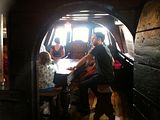 This meant that it should be possible to sail ships around the bottom of South America, south of Tierra. This was the Cape Horn route, eventually discovered in 1616. As Drake sailed further up the coast, he plundered Spanish ports in Chile and Peru and captured treasure ships. His biggest prize was the Cacafuego. On the way he landed in what is now California, naming it Nova Albion
This meant that it should be possible to sail ships around the bottom of South America, south of Tierra. This was the Cape Horn route, eventually discovered in 1616. As Drake sailed further up the coast, he plundered Spanish ports in Chile and Peru and captured treasure ships. His biggest prize was the Cacafuego. On the way he landed in what is now California, naming it Nova Albion(New England) and claiming it for the Queen.
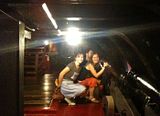 He then continued across the Pacific to the East Indies. Drake returned from his voyage around the world with the little Golden Hinde packed full of spices and plundered Spanish silver, which at the time was more valuable than gold. On 26 September, Golden Hinde sailed into Plymouth with Drake and 59 remaining crew aboard, along with a rich cargo of spices and captured Spanish treasures. The Queen's half-share of the plunder surpassed the rest of the crown's income for that entire year.
He then continued across the Pacific to the East Indies. Drake returned from his voyage around the world with the little Golden Hinde packed full of spices and plundered Spanish silver, which at the time was more valuable than gold. On 26 September, Golden Hinde sailed into Plymouth with Drake and 59 remaining crew aboard, along with a rich cargo of spices and captured Spanish treasures. The Queen's half-share of the plunder surpassed the rest of the crown's income for that entire year. 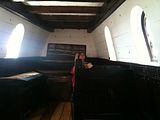
Drake was knighted by Queen Elizabeth aboard Golden Hinde on 4 April 1581; the actual act being performed by a French diplomat, Monsieur de Marchaumont, who was negotiating for Elizabeth to marry the King of France's brother. By getting the French diplomat involved in the knighting, Elizabeth was gaining the implicit political support of the French for Drake's privateer actions against the Spanish.
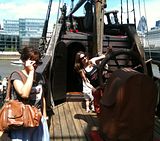 Quite remarkably, the modern replica of Golden Hinde has actually sailed longer distance than the original one and under similar conditions. When at sea, it is crewed by a Master, Mate, Cook and 10 to 12 deckhands, while in Drake's time there were 60-80 crew. An obvious difference with the original is that it has a wheel, which wouldn't be common at the time. The original had a pole attached to the rudder.
Quite remarkably, the modern replica of Golden Hinde has actually sailed longer distance than the original one and under similar conditions. When at sea, it is crewed by a Master, Mate, Cook and 10 to 12 deckhands, while in Drake's time there were 60-80 crew. An obvious difference with the original is that it has a wheel, which wouldn't be common at the time. The original had a pole attached to the rudder.The guided tour aboard the Golden Hinde is delightful and really cheap (£7).
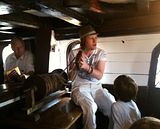
Learning about the way the guns operated was superb, but I was impressed the most by the origin of the knot as unit of speed. Until the 19th century, speed at sea was measured using a wooden panel, weighted on one edge to float upright, attached by line to a reel. It was cast over the stern of the moving vessel and the line allowed to pay out. Knots placed at a distance of 47 feet 3 inches passed through a sailor's fingers, while another sailor used a 28 second sandglass to time the operation. The knot count would be the speed of the vessel. The speed of Golden Hinde was 8 knots.
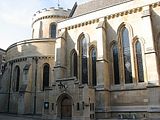
Next on our itinerary was the Temple Church, but it was closed to the public because it hosted a wedding. Oh well, nevermind. Straight to Holborn for Sir John Soane's Museum and maybe a beer at Princess Louise.
Sir John Soane's Museum
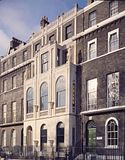 Being one myself, I've always had a soft spot for collectors, and Sir John Soane is one of the greatest I am aware of. One of the most successful architects of his time, he was rich enough to buy the Sarcophagus of Seti I (1290 BC) that the British Museum had found too expensive. Soane designed his house in Holborn to live in, but also as a setting for his antiquities and his works of art. After the death of his wife in 1815, he lived there alone, constantly adding to his collections. Disappointed by the conduct of his two sons, he managed to have an Act of Parliament passed, establishing that after his death his
Being one myself, I've always had a soft spot for collectors, and Sir John Soane is one of the greatest I am aware of. One of the most successful architects of his time, he was rich enough to buy the Sarcophagus of Seti I (1290 BC) that the British Museum had found too expensive. Soane designed his house in Holborn to live in, but also as a setting for his antiquities and his works of art. After the death of his wife in 1815, he lived there alone, constantly adding to his collections. Disappointed by the conduct of his two sons, he managed to have an Act of Parliament passed, establishing that after his death his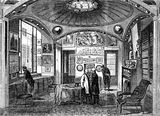 house would become a museum that would be free of charge and "as nearly as possible in the state in which he shall leave it". 173 years later this still holds true.
house would become a museum that would be free of charge and "as nearly as possible in the state in which he shall leave it". 173 years later this still holds true.Soane was also a Professor of Architecture at the Royal Academy and used his house to educate and inspire "Amateurs and Students in Painting, Architecture and Sculpture". All
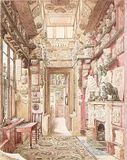 rooms and corridors in the house are packed with exhibits of all kinds. Quoting the museum's guide, everything is arranged in a way that draws the eye to the beauty of the form and the variety of carved ornament. The image on the right shows the study as painted by Joseph Gandy in 1822. It looks almost identical today.
rooms and corridors in the house are packed with exhibits of all kinds. Quoting the museum's guide, everything is arranged in a way that draws the eye to the beauty of the form and the variety of carved ornament. The image on the right shows the study as painted by Joseph Gandy in 1822. It looks almost identical today.As I understand painting more than architecture and sculpture, my favourite items from his home were the Canaletto, Hogarth and Turner paintings. Hogarth's "An Election Entertainment" shows two candidates (on the two sides of the table) trying to gain voters'
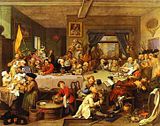 support, but a man is trying to burn the wig of the one and a pair of drunks abuse the other. The Mayor has collapsed after consuming too many oysters, the election agent is struck by a brick thrown by the Tories outside, and a Quaker is carefully examining an I.O.U. bribe. At the foot of the wounded man lies a banner reading 'Give us our Eleven Days' referring to the adoption of the Gregorian calendar in 1752 when it had been necessary to skip from 3 to 14 September. Many voters actually thought that they had been robbed of eleven days of their lives.
support, but a man is trying to burn the wig of the one and a pair of drunks abuse the other. The Mayor has collapsed after consuming too many oysters, the election agent is struck by a brick thrown by the Tories outside, and a Quaker is carefully examining an I.O.U. bribe. At the foot of the wounded man lies a banner reading 'Give us our Eleven Days' referring to the adoption of the Gregorian calendar in 1752 when it had been necessary to skip from 3 to 14 September. Many voters actually thought that they had been robbed of eleven days of their lives. 
Soane died in 1837 and was buried in the tomb he designed for his wife and himself in the churchyard of St. Pancras Old Church. This tomb provided the inspiration for the design of the red telephone booths.
No comments:
Post a Comment